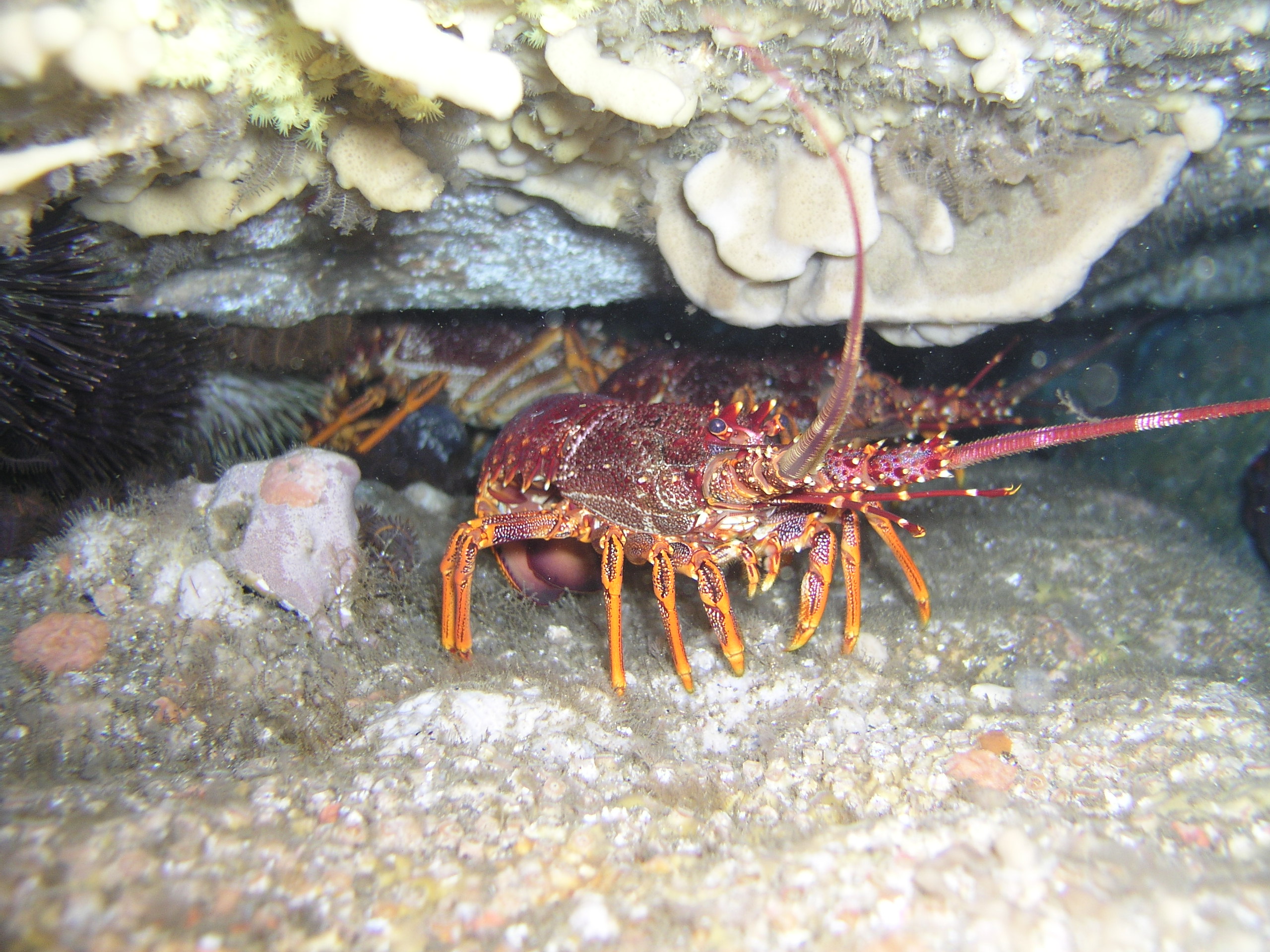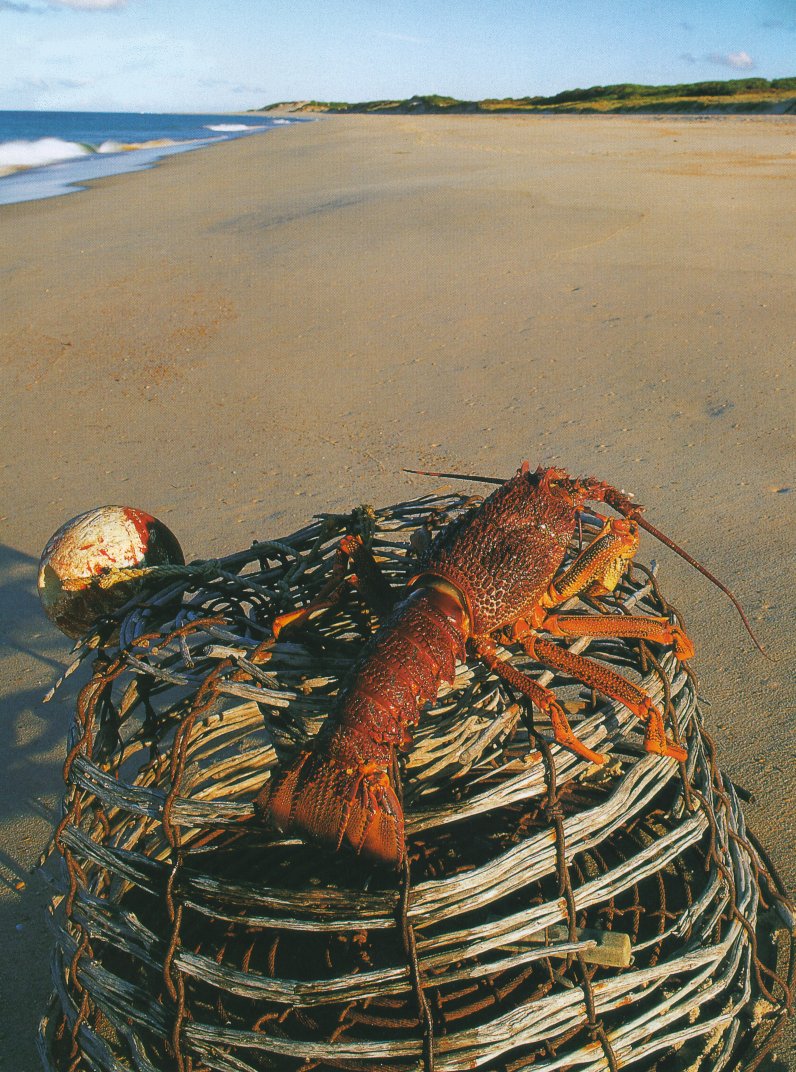Background

Rock lobsters in a rocky crevice.
The First Custodians
Harvesting of the southern rock lobster first commenced with the arrival of the Aboriginal people in Tasmania over 35 000 years ago (Cameron 2006; Breen 2015). Founding Aboriginal communities fished southern rock lobster from coastal areas around Tasmania which, along with seals, mutton-birds and shell-fish, complemented the terrestrial diet of Indigenous Tasmanian people for thousands of years (Woodward 2006; National Oceans Office 2002). Today, Indigenous harvest of the southern rock lobster continues.
European Settlement
An abundance of marine resources including the presence of large rock lobsters in Tasmania supported the establishment of a British colony along the Derwent River in 1803 during periods of provision rationing and supply limitations (Howeler-Coy 1966). The arrival of European settlers facilitated the development of economic enterprise in Tasmania that established marine industries including a rock lobster fishery. At the Maria Island penal colony, established in 1925, it was necessary for convicts to fish and hunt to supply food for the population and since 1830 the region has supported fishing communities with plentiful lobster catches which were used for food and income.
A strong recreational or subsistence fishing culture also developed among the European settlers between the 1800s and 1870s (Fenton 1884). Lobsters were ideal catch without the presence of refrigeration or ice as they could be caught close to settlements (Harrison 2008). The popularity of the southern rock lobster among early European settlers to Tasmania was featured in the book ‘The English and Australian Cookery’ by Edward Abbott in 1864 (Howeler-Coy 1966). These early commercial and recreation rock lobster fishers were unregulated, and catches went unrecorded.
Establishment of Commercial Fisheries
In 1885, the first legislation for regulating the harvest of southern rock lobster the “Crayfish Act (1885)” was implemented. The adoption of the Act was in response to a Royal Commission into Tasmanian fisheries in 1882 that outlined concerns at the time over the sustainability and protection of marine resources. The Crayfish Act (1885) introduced catch size limits and prohibited the capture or sale of females in berry (carrying eggs).
The following century saw the increasing adoption of management restrictions as the southern rock lobster fishery expanded. For example, the number of pots in the fishery increased by almost 7000 between 1956 and 1972. During the mid 1880s to 1920s the fishery was managed by 23 Commissioners of the Fisheries Board debated and banned the use of pots (hemispherical or baited hoop), the merits of different gear types, and conflicts between Victorian and Tasmanian fishers. In 1925, a newly appointed Sea Fisheries Board legalised the use craypots ending the ‘great craypot debate 1885-1925’ and implemented further regulations for the management of the fishery. These new management strategies included limitations on the number of pots on a vessel, introduced minimum legal lengths and prohibited the capture and sale of soft-shelled juveniles (Harrison 2008).

Rock lobster on a cray pot.
Although economic prosperity in Tasmania declined during the Great Depression and World War I and II, the southern rock lobster fishery was generally resilient and slowed periodically due to decreased market demand. The legalisation of pots had resulted in an increase in commercial catch and efficiency. The fishery was also spurred on by technological and operational advances following World War II and achieved levels of prosperity not previously observed (Harrison 2008). These advances included improved vessel machinery (e.g. pot haulers) that allowed fishers the ability to catch in deeper water more efficiently and expanded market demand with air freight increasing the export capability of catches from Tasmania to the mainland and eventually overseas. For example, the development of refrigeration enabled the expansion into the American frozen lobster tail market. To manage the success of the fishery, commercial licences were limited to 442 in 1966 and subsequent strategies to reduce the number of licences were introduced.
The peak southern rock lobster catch was recorded in 1985 at 2217 tonnes. However in the mid-1980s a decline in catches amid increased effort prompted concern over the future of the fishery. With decreased catches the fishery expanded its fishing grounds further offshore into deeper waters. Although the Tasmanian rock lobster fishery occurs in both Commonwealth and State waters, since 1986 the Tasmanian Government has had jurisdiction over the industry south of 39o 12’ and within 200 nautical miles of the coastline.
Inception of Individual Transferable Quotas (ITQs)
Ongoing declining catch rates prompted a government review into the southern rock lobster fishery in 1992. The following five years in the industry were characterised by reviews and debates focused on the best direction for the fishery management to take into the future. By 1996, ongoing strategies to reduce the number of commercial licences had decreased the number to 321 from 442 in 1966 (a 27% decrease). After prolonged concerns over the sustainability of the fishery, a change the management structure occurred in 1996 from a commercial fishery that was managed by input controls (e.g., number of pots and licences) to one managed by the control of fishery outputs (e.g., total catch quotas). Some input controls have remained in place despite the adoption of output controls such as limitations on the number of pots and seasonal closures.
In 1998/1999 season, an individual transferable quota (ITQ) management system was implemented in the Tasmanian rock lobster fishery. Under ITQ management, commercial licence holders are allocated a proportion of the total catch quota to harvest. The ITQ management system changed the catch strategy of fishers from a race to catch early in the season to a profit maximisation approach in which fishers aim to increase the economic return by catching at periods of high market prices and catchability (Frusher et al. 2003). In the two years following the implementation of ITQs the catch and fishing-effort (vessel days) had both decreased (17% and 28%, respectively) (FAO 2001). A change in fishing behaviour was also observed with an increase in catch in winter when the beach price is higher, and fishers obtain a greater price per catch (Frusher et al. 2003).
The introduction of ITQs also changed the fleet dynamics with the number of vessels declining from almost 300 in 1996 to 164 in 2020/21. This has occurred as quota ownership is consolidated among larger operators and vessels who are able to generate greater profit from a given amount of quota. The downside to this increased economic efficiency is a reduction in employment and regional economic activity.



